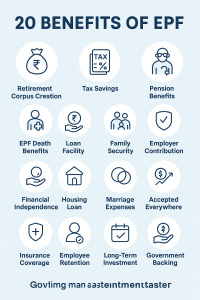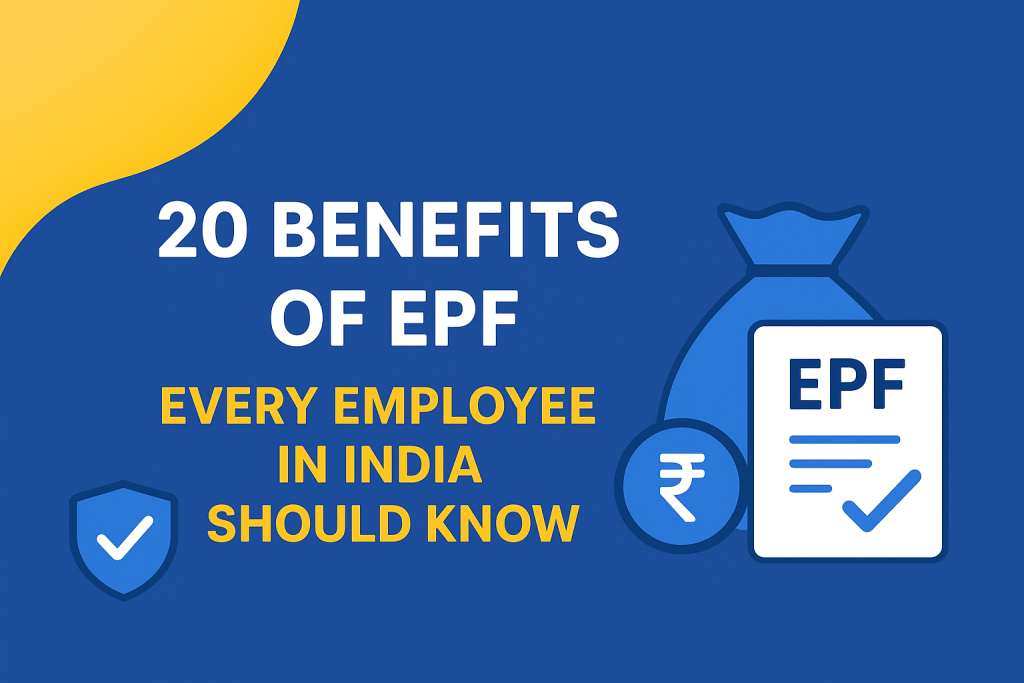The Employees’ Provident Fund (EPF) is one of the most significant social security and retirement savings schemes for salaried individuals in India. Managed by the Employees’ Provident Fund Organisation (EPFO), the scheme ensures that employees save regularly during their working years, creating a strong financial cushion for retirement.
For most salaried professionals, the EPF is often the first formal investment they make, and it continues throughout their career. But the scheme is not limited to just retirement—it offers multiple benefits across financial planning, tax savings, insurance, and social security. Know more about EPF.
We’ll go into great detail about the benefits of EPF in this extensive tutorial. Whether you’re a new employee trying to understand the scheme, or an experienced professional looking for advanced insights, this blog will give you a clear understanding of why EPF is considered one of the most valuable savings tools in India.
Financial Benefits of EPF
1. Builds a Reliable Retirement Corpus
The fact that EPF guarantees a consistent accumulation of a retirement fund is one of its main advantages. Your employer’s contribution is matched by the mandatory monthly deduction of a percentage of your pay, which is then put into your EPF account. Over decades of service, these contributions, combined with interest, grow into a significant corpus. For example, an employee contributing ₹5,000 per month for 30 years with employer matching and an interest rate of around 8% could accumulate more than ₹1 crore by retirement. This makes EPF a foundation for financial security post-retirement.
2. Employer Contribution Boosts Savings
Unlike voluntary savings schemes where only your money is invested, EPF is unique because your employer also contributes. Usually, 12% of the base pay and dearness allowance are contributed by the business and the employee. While the full employee contribution goes into EPF, a part of the employer’s share is diverted into the Employees’ Pension Scheme (EPS). This dual contribution doubles your saving ability without any extra effort on your part—making EPF a truly rewarding savings vehicle.
3. High Interest Rate Compared to Banks
Another major advantage is that the interest on EPF is relatively high and is compounded annually. The rate, declared by EPFO each year, usually remains higher than savings accounts and even some fixed deposits. Historically, the rate has been in the range of 8%–9%, which is a safe and attractive return given that the investment is government-backed.
4. Long-Term Wealth Creation Through Compounding
The benefits of compounding increase with the length of time you contribute. EPF is a long-term instrument, meaning that even small monthly contributions accumulate into large sums over decades. For instance, a contribution of ₹3,000 per month for 25 years could multiply to over ₹40 lakh, purely through compounding interest. This wealth creation aspect makes EPF indispensable for retirement planning.
5. Job Security Cushion During Unemployment
In times of uncertainty, such as job loss or layoffs, EPF offers a cushion. After two months of being unemployed, employees can withdraw 75% of their EPF balance, and 25% after three months. This facility provides temporary financial relief until a new job is secured.
Tax Benefits of EPF
6. Tax Deduction under Section 80C
One of the most appealing tax benefits of EPF is that contributions made by employees are eligible for deduction under Section 80C of the Income Tax Act. You can claim up to ₹1.5 lakh per year, reducing your taxable income significantly. This makes EPF both a savings and tax-saving tool.
7. Tax-Free Interest Earnings
The interest earned on EPF deposits is exempt from tax (within prescribed limits). This feature enhances the effective returns since you don’t have to pay any tax on the annual accrual of interest. In contrast, interest on bank FDs is taxable, which reduces their attractiveness compared to EPF.
8. Tax-Free Maturity Amount
Another powerful tax benefit of EPF is that the maturity amount, which includes contributions and accumulated interest, is completely tax-free provided you have completed five continuous years of service.Therefore, EPF is part of the EEE category of investments: exempt at the time of investment, exempt on interest, and exempt upon withdrawal.
Social Security & Insurance Benefits
9. Pension Through Employees’ Pension Scheme (EPS)
In addition to EPF, employees are automatically enrolled in the Employees’ Pension Scheme (EPS). A portion of the employer’s contribution is diverted into EPS, which ensures that employees receive a monthly pension after retirement, or in case of disability. This provides long-term income security, ensuring that retirees don’t outlive their savings.
10. EPF Death Benefits under EDLI Scheme
A lesser-known but extremely valuable aspect of EPF is the EPF death benefits provided through the Employees’ Deposit Linked Insurance (EDLI) scheme. Upon death during the employment period, a nominee is entitled to an insurance payout (up to ₹7 lakh as per current rules).. This acts as financial protection for the family and ensures continuity of income in difficult times.
Know more about EPF, PPF And VPF.
11. Protection Against Attachments
Another benefit of EPF is its legal safety. EPF balances cannot be attached by any court decree or government order, even in cases of debt or insolvency. This ensures that your retirement savings remain untouchable and secure, giving you peace of mind that your funds are exclusively yours.

Withdrawal & Emergency Support
12. Loan Facility for Specific Needs
Partial withdrawals from the EPF are permitted for certain uses, including marriage, education, home building, and medical care.
13. Medical Assistance
Healthcare expenses can be overwhelming, and EPF provides a helping hand by allowing withdrawals for treatment of serious illnesses for self, spouse, children, or dependent parents. This benefit ensures that medical emergencies do not disrupt long-term financial stability.
14. Housing Assistance
Owning a home is a dream for many, and EPF can support this by allowing withdrawals for house purchase, construction, or even repayment of a home loan. This makes EPF not just a retirement fund, but also a support system for major life goals.
15. Emergency Fund Access
In times of natural calamities, pandemics, or sudden financial crises, EPF permits partial withdrawals to ease the burden. For example, during the COVID-19 pandemic, the EPFO allowed employees to withdraw funds to support their families, proving its role as a lifeline in emergencies.
Convenience & Accessibility
16. Compulsory Savings Habit
There is a major advantage to EPF that is often overlooked: discipline. The automatic deduction of contributions every month makes employees feel obligated to save consistently. Over time, this compulsory saving habit builds financial responsibility.
17. Government Backed and Safe
Unlike market-linked instruments, EPF is fully backed by the Government of India, making it virtually risk-free. Employees do not have to worry about market volatility or loss of principal, ensuring complete financial safety.
18. Portability with Universal Account Number (UAN)
EPF is now portable thanks to the Universal Account Number (UAN). Employees changing jobs can easily transfer their balances online, eliminating the problem of multiple accounts and ensuring continuous growth of their savings.
19. Online Access and Transparency
With the digitization of EPF services, employees can now check balances, contributions, and interest accruals online through the EPFO portal or UMANG app. This transparency empowers employees to track their savings in real-time.
20. Financial Independence Post-Retirement
Last but not least, the EPF can help ensure financial independence after retirement. The combination of a lump sum corpus and monthly pension ensures that employees can live with dignity and without financial dependence on others.
Benefits of EPF to the Employer
While much focus is given to employees, there are also benefits of EPF to the employer. Contributing to EPF helps organizations attract and retain talent, ensures compliance with statutory regulations, and builds goodwill as a socially responsible employer.
Benefits from EPF vs. PPF
Both EPF and PPF are long-term saving instruments, but EPF offers added advantages such as employer contribution, pension benefits, and insurance cover. This makes EPF more holistic compared to PPF.
Benefits of EPF to Employee
To summarize, the benefits of EPF to employee include financial security, tax savings, pension, insurance, emergency withdrawals, and complete government backing.
Conclusion
The benefits of EPF are wide-ranging—covering retirement planning, tax savings, insurance, emergency support, and social security. It is not just a savings tool but a comprehensive financial safety net for employees in India. With features like portability, online access, and government backing, EPF continues to be one of the most reliable investments for salaried professionals.
Employees should actively track their EPF accounts, update nominations, and understand withdrawal rules to make the most of this scheme. By leveraging the benefits from EPF, you can secure your present as well as your future.
Whether you are looking at the tax benefits of EPF, the EPF death benefits for your family, or the overall benefits of PF to employee and employer alike, one thing is clear: EPF remains one of the most valuable and trustworthy financial instruments in India.
At Care4Share, we go beyond just explaining the benefits of EPF—we help you experience them without hurdles. Our team specializes in resolving PF-related issues such as name or signature mismatches, incorrect KYC details, and delays in withdrawals or transfers. We also assist families in claiming EPF death benefits, ensuring a smooth process during difficult times. Whether you are an employee planning for retirement or a nominee securing rightful dues, Care4Share provides expert guidance and end-to-end support. With our transparent approach, we make sure you get the maximum value from your EPF savings. Recover your old investment
Frequently Asked Questions (FAQs) on Benefits of EPF
1. What are the main benefits of EPF for employees?
The main benefits of EPF include retirement corpus creation, tax savings, pension benefits, life insurance cover through EDLI, and emergency withdrawal options. It also provides job security during unemployment and ensures financial independence post-retirement.
2. What are the EPF death benefits available to nominees?
If an employee passes away during service, their nominee is eligible for EPF death benefits under the Employees’ Deposit Linked Insurance (EDLI) scheme. The nominee may receive up to ₹7 lakh as insurance coverage, in addition to the employee’s accumulated EPF and pension benefits. This ensures financial support to the family in difficult times.
3. What are the tax benefits of EPF?
The tax benefits of EPF are threefold:
- Contributions are deductible under Section 80C (up to ₹1.5 lakh annually).
- Interest earned on EPF is tax-free (within prescribed limits).
- The maturity amount is tax-free after five years of continuous service.
This makes EPF an EEE (Exempt-Exempt-Exempt) instrument.
4. What are the benefits of PF to employee compared to PPF?
The benefits of PF to employee are greater than PPF because PF includes employer contributions, pension (EPS), and life insurance (EDLI). While PPF is also tax-free and secure, EPF provides more comprehensive financial protection through retirement income and death benefits.
5. What are the benefits of EPF to the employer?
The benefits of EPF to the employer include compliance with government regulations, improved employee retention, and building a reputation as a responsible employer. Offering EPF makes companies more attractive to skilled professionals, reducing attrition rates and increasing loyalty.
6. Can employees withdraw EPF before retirement?
Yes, employees can partially withdraw EPF before retirement for specific reasons such as marriage, education, medical emergencies, or house construction. However, the full withdrawal is permitted only after retirement or if the employee remains unemployed for over two months. This flexibility is one of the underrated benefits from EPF.
7. How does EPF ensure financial independence after retirement?
One of the most important benefits of EPF is that it ensures financial independence after retirement. Employees receive a lump sum corpus along with pension benefits from EPS. This dual income source means retirees don’t have to depend on others for their financial needs in old age.

